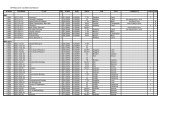Kenwood TH-D7A
Kenwood TH-D7A
Kenwood TH-D7A
You also want an ePaper? Increase the reach of your titles
YUMPU automatically turns print PDFs into web optimized ePapers that Google loves.
Let us describe four basic methods for editing a packet<br />
path.<br />
Method 1 (Specific path):<br />
Program the call signs of one or more digipeaters in the<br />
sequence of transfer relay; ex. “KD6ZZV,KF6RJZ”.<br />
Method 2 (Generic path):<br />
Program “RELAY” and/or “WIDE”; ex. “RELAY,WIDE”. In<br />
this example, APRS data is transferred to any relay-type<br />
digipeater near your position first, then to any wide-type<br />
digipeater. You can also program more than one<br />
“WIDE”. If you enter “WIDE,WIDE” for example, APRS<br />
data will be transferred to any wide-type near your<br />
position first, then to another wide-type. This method<br />
relieves you from specifying the call signs of digipeaters.<br />
Method 3 (WIDEN-N path):<br />
Program “WIDEN-N”, where both Ns indicate the number<br />
of wide-type digipeaters to be used for relay. If you enter<br />
“WIDE3-3” for example, APRS data will be relayed by<br />
three digipeaters in any direction.<br />
Note: This method is supported only by advanced APRS networks.<br />
Method 4 (SSID path):<br />
Program a single number 1 to 15. You can easily specify<br />
the number of digipeaters that will be used for relay. You<br />
can also specify which directions of digipeaters relative<br />
to your position will be used. See the table.<br />
Note: This method is supported only by advanced APRS networks.<br />
Parameter<br />
Number of<br />
digipeaters<br />
Direction<br />
1 1 All<br />
2 2 All<br />
3 3 All<br />
4 4 All<br />
5 5 All<br />
6 6 All<br />
7 7 All<br />
8<br />
1<br />
2 (or more)<br />
North<br />
9<br />
1<br />
2 (or more)<br />
South<br />
10<br />
1<br />
2 (or more)<br />
East<br />
11<br />
1<br />
2 (or more)<br />
West<br />
12<br />
2<br />
Many<br />
North<br />
13<br />
2<br />
Many<br />
South<br />
14<br />
2<br />
Many<br />
East<br />
15<br />
2<br />
Many<br />
West<br />
1 The first digipeater which receives your APRS data specifies<br />
the entire route to the destination before forwarding; often 2<br />
digipeaters are used in total.<br />
2 The digipeater which receives your APRS data specifies the<br />
call sign of the next digipeater before forwarding. This is<br />
repeated until your APRS data reaches the destination.<br />
1<br />
2<br />
3<br />
4<br />
5<br />
6<br />
7<br />
8<br />
9<br />
10<br />
11<br />
12<br />
13<br />
14<br />
15<br />
16<br />
17<br />
18<br />
19<br />
20<br />
21<br />
22<br />
23<br />
73

















